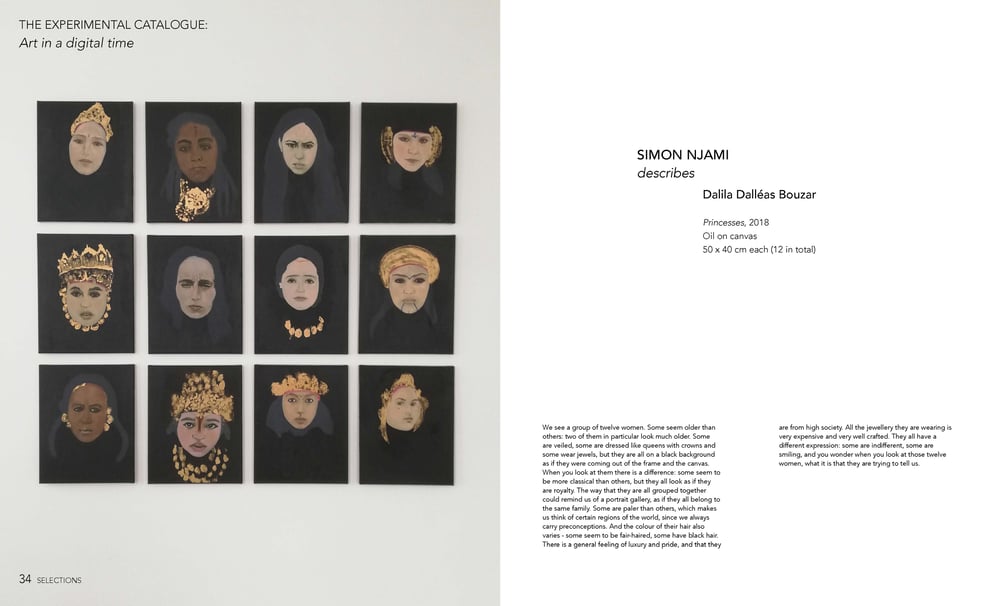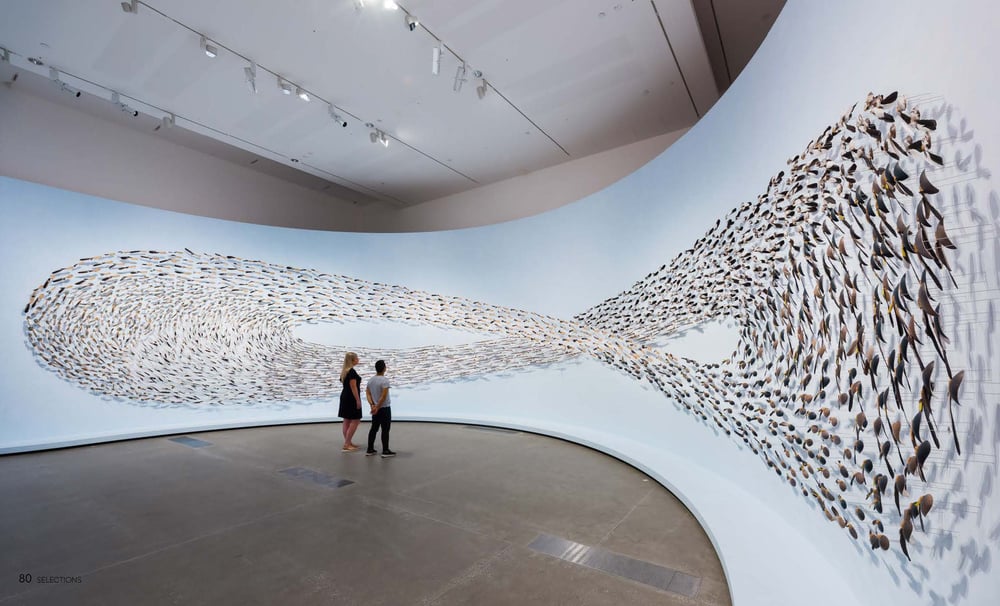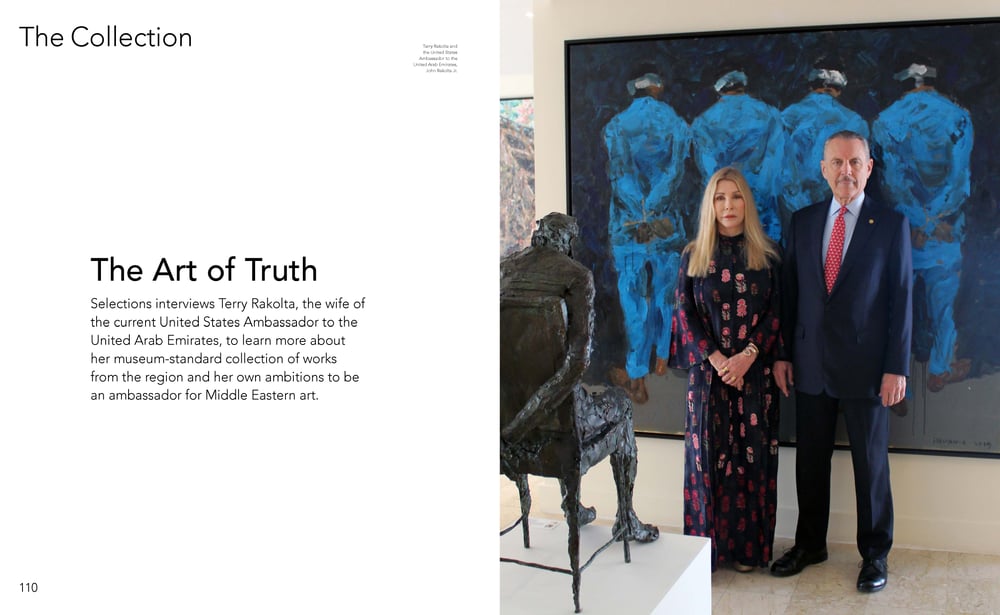The Experimental Catalogue #54
$20.00
Following the compulsory trend of taking business online, we went on a virtual art quest and came up with what we have called an experimental catalogue.
The concept behind this issue's experimental catalogue theme consists of understanding an artwork through the eyes of our 10 guests. As our contributors, they take us step by step through understanding an artwork, from the very first moment they lay their eyes on it, to understanding what you are looking at and placing the piece contextually while also getting into the artist's story and their relationship with them.
We also wanted to share with you the context of the interviews themselves, to give you a sense of the passionate and insightful conversations we enjoyed with each one of the participants. We would like to truly thank each and every one of them for taking the time to complete this exercise. The main takeaway, at least for us, is that perhaps it's sometimes necessary – and enriching – to pause, observe and reflect.
Nada Raza
Nada Raza is one of the six curators invited to curate a special exhibition during the virtual Abu Dhabi Art Fair that was held between November 19 - 26. At the press conference, an interesting debate arose about the speed at which we receive information and how easy it is to swipe to the next subject. Raza wanted to defy this by approaching the matter 'ergonomically', based on the idea it is up to us to control technology and its speed rather than it controlling us. To this effect, she created a suspenseful exhibition, revealing a new artist daily on the Abu Dhabi Art platform for the show titled A Picture Held Us Captive. The selection of works brings into question the primacy of the visual in our shift to consuming art online. For this issue of SELECTIONS magazine, Raza selects a work from A Picture Held Us Captive by Pakistani artist Fazal Rizvi entitled The Blue Drawings, accompanied by an excerpt of sound-based work entitled These Fissures in the Deep. My question about what she anticipates for the near future made her confess that it is OK to take some time to heal from what 2020 had up its sleeve for us.
Simon Njami
Simon Njami is one of the six curators of the digital Abu Dhabi Art Fair that took place at the end of November. The artwork he selected to discuss for SELECTIONS was exhibited at the fair in a section he curated that was entitled The Day After. Although it is challenging to be able to look at an artwork as if you are viewing it for the first time when you have already seen it and lived with it, Njami excelled at our exercise.
Our call with Njami started off with a resonating piece by Shubert playing in the background while Njami sat at the footsteps of his seemingly endless library. He explained that his library continues to grow as he collects more reading material while refusing to go digital, despite pleas from his children. Out of the blue, he lit a cigarette that I could smell through the screen, sat cross-legged, shifting his weight onto one side of the seat, and continued his discussion. Alongside his numerous literary references, it felt like a perfect film noir scene from Jean-Luc Goddard’s repertoire, set up for a leisurely debate about art over coffee and cigarettes.
Geraldine Barlow
Geraldine Barlow is head of international art for the Queensland Art Gallery and Gallery of Modern Art in Brisbane, Australia. I was so eager to have a conversation with her, but I realised when setting up the call and tackling time zones that there wasn't a time that could be defined as a normal working hour that would be normal for both of us. This made me ponder how big planet Earth is, and yet how small it is that we can connect digitally.
Our subject was a beautiful installation taking over the walls of the gallery, observing the magical and mysterious dance of a flock of birds. It was a conversation that made me realise how much there is still to learn about cultures around the world, how complex they can be, and how fragile they are when pitted against today’s globalised world.
Maya El Khalil
Maya El Khalil spoke to us from Oxford where she is currently living. Recently, El Khalil has been working with up-and-coming artists. She is one of the six curators invited to curate a special exhibition during the virtual Abu Dhabi Art Fair, where she shed light on some of the UAE’s most promising emerging talent as curator of the programme Beyond: Emerging Artists. The works she selected for the fair were purposely exhibited unfinished.
Sam Bardaouil and Till Fellrath
Sam Bardaouil and Till Fellrath were our first guests in this issue. Hats off to the duo for their dedication and for elegantly surpassing the challenges. They opted to submit their own written words and decided to approach the theme by submitting a ‘before/after’ text about the same artwork, a photograph by Zineb Sedira, an artist they have worked with on two separate occasions in their career.
Sabrina Amrani
Sabrina Amrani's dynamic personality is diffused throughout her galleries in Malasaña and Carabanchel, Madrid. However, back in March, after she launched the show Vision de Tunel (Tunnel Vision), featuring a body of work by artist Dagoberto Rodriguez, her active lifestyle was suddenly put on hold by a lockdown due to the pandemic. The result was that she was left with plenty of time on her hands to observe the intricate body of work in the show. She brings her observations to the discussion for this issue of SELECTIONS.
Hala Khayat
Hala Khayat is a scholar on Arab and Middle Eastern Modern and Contemporary art and has been integral in developing Christie’s Dubai since its inception in 2007, playing a key role in the expansion and globalisation of the Middle East’s art market both within the UAE and the greater region. Recently Art Dubai gained her expertise with her appointment as regional director.
Khayat selected an artwork that particularly spoke to her when she was least expecting it, when she ceased looking at an artwork from a business point of view, dropped her habitual guard and analytical perception, and allowed the artwork to talk to her.
Dyala Nusseibeh
Dyala Nusseibeh is the director of the Abu Dhabi Art Fair. She selected an artwork by the Iranian trio Ramin Haerizadeh, Rokni Haerizadeh and Hesam Rahmanian related to a work that had been executed by them on a concrete pillar in a public park in Abu Dhabi. Nusseibeh decided to focus on the parallelism between the artwork she selected that was on show during Abu Dhabi Art and the original artwork situated in the Abu Dhabi Skate Park that inspired it.
Marc Pottier
Curator and art advisor, Marc Pottier is particularly passionate about public art and creating shows in public spaces. We first met Marc Pottier, a world traveller, a few years ago in Beirut. More recently, SELECTIONS Viewing Rooms hosted his latest show in Brazil entitled Sit, Read, Write. Pottier has been dedicating a lot of time to Brazilian artists and his choice of artist for this issue, Janaina Tschäpe, was born in Munich, Germany but raised in Sao Paulo, Brazil.
Humberto Moro
Humberto Moro is the deputy director and senior curator at Museo Tamayo, Mexico City and adjunct curator at SCAD Museum of Art, Savannah, GA. For this issue of SELECTIONS, Moro selected a work by Mexican artist Tania Pérez Córdova, whose sculptural compositions, seemingly static pieces, suggest the passing of time.
Anastasia Nysten,
Editor-in-Chief





